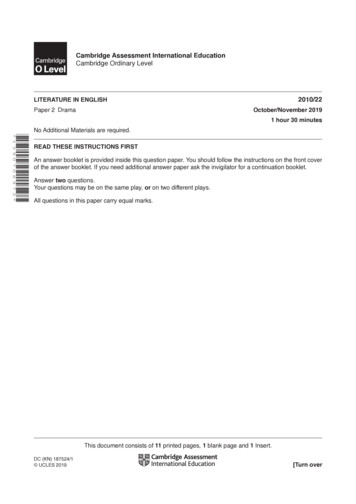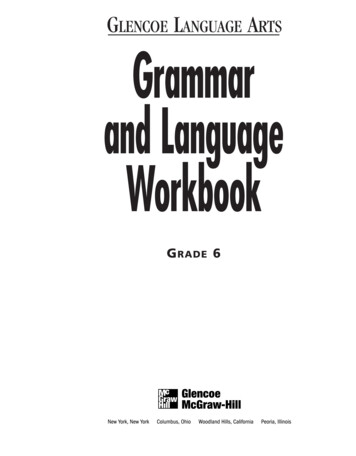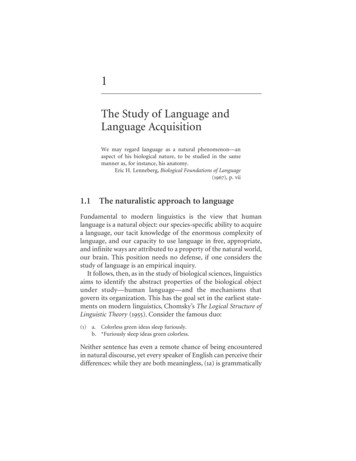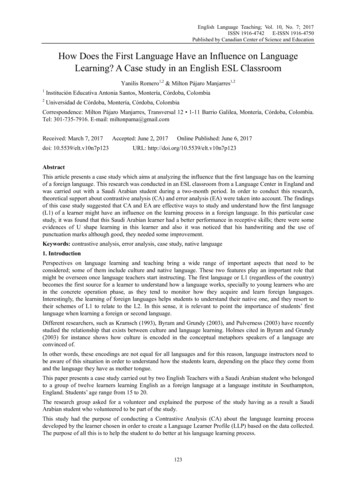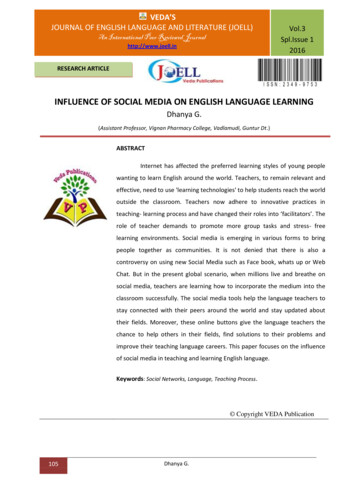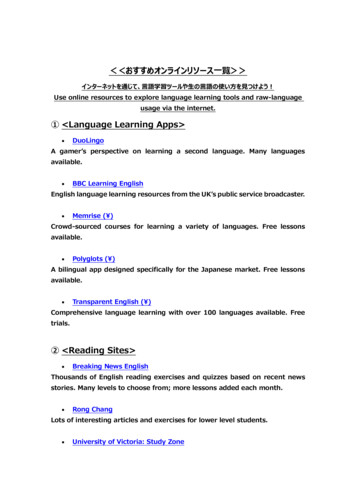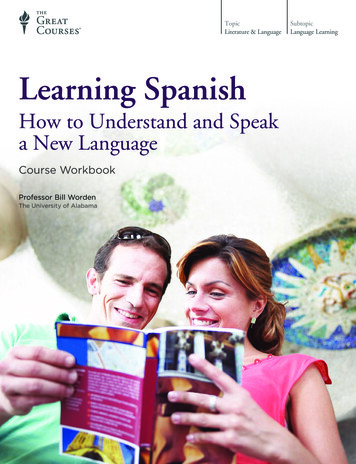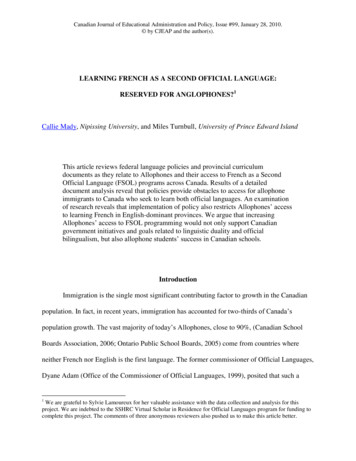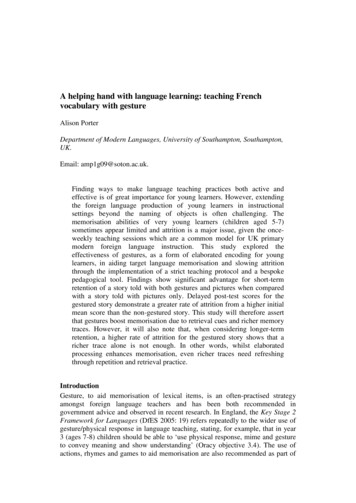
Transcription
Learning languagein chunksPart of the Cambridge Papers in ELT seriesJuly 2019CONTENTS2Introduction3Key terms4Key issues5Research and literature review:significant findings16Key considerations17Summary: What are theimplications for teachers?18Conclusion19Recommendations for furtherreading plus useful websites20Bibliography
IntroductionIt was over 25 years ago that Michael Lewis publishedThe Lexical Approach (Lewis, 1993), prompting aradical re-think of the way that we view language –and, by extension, of the way that we teach it.In contrast to the then prevailing structural account, inwhich language was viewed as comprising grammaticalstructures into which single words are slotted, Lewis arguedthat ‘language consists of chunks which, when combined,produce continuous coherent text’ (Lewis, 1997: 7).By ‘chunks’, Lewis was referring to everything from: collocations (wrong way, give way, the way forward) fixed expressions (by the way, in the way) formulaic utterances (I’m on my way; no way!) sentence starters (I like the way ) verb patterns (to make/fight/elbow one’s way ) idioms and catchphrases (the third way; way to go!) everything, in fact, that doesn’t fit neatly intothe categories of either grammar (as traditionallyconceived) or single-word vocabulary.Lewis was by no means the first to describe languagein these terms: his singular contribution was toargue that, in order to accommodate this alternativedescription, it was language teaching that neededto be reformed – or, indeed, revolutionised.This paper charts the extent to which the Lexical Approach,or ‘learning language as chunks’, as Lewis and subsequentscholars conceived it, is being applied a quarter of a centuryon, and the research that underpins such an approach.2
Key termschunk:idiomaticity:an all-purpose word that embraces any formulaic sequence,lexical/phrasal expression or multi-word item.the degree to which a particular wording isconventionalised in the speech community. For example,the time 3.20 is said as ‘twenty past three’ or ‘three twenty’,but not ‘three and a third’ (as its Egyptian Arabic equivalentwould be translated, for example).cluster (or bundle):any commonly occurring sequence of words, irrespective ofmeaning or structural completeness, e.g. at the end of the,you know what.collocation:two or more words that frequently occur together, e.g. falseeyelashes, densely populated, file a tax return.corpus:a database of texts, typically authentic, which is digitallyaccessible for the purposes of calculating frequency,identifying collocations, etc.formulaic language:‘a sequence, continuous or discontinuous, of words orother meaning elements, which is, or appears to be,prefabricated: that is, stored and retrieved whole frommemory at the time of use, rather than being subject togeneration or analysis by the language grammar’ (Wray,2000: 465).functional expression:formulaic ways of expressing specific language functions,e.g. Would you like.? (for inviting).idiom:an expression whose meaning is not the sum of itsindividual words, i.e. it is ‘non-compositional’, e.g. a wildgoose chase, run out of steam, plain sailing.idiom principle:the principle of language use whereby ‘a languageuser has available to him or her a large number of semipreconstructed phrases that constitute single choices, eventhough they might appear to be analysable into segments’(Sinclair, 1991: 110). This contrasts with the ‘open choiceprinciple’, where the only restraint on word choice is‘grammaticalness’.lexical approach:an approach to language teaching that foregrounds thecontribution of vocabulary, including lexical chunks, tolanguage use and acquisition.lexical phrase:one of many alternative terms to describe multi-word items.MI (Mutual Information):a statistical measure of the strength of a collocation basedon the likelihood of its individual elements occurringtogether more frequently than would be expected bychance: short straw, for example, has a higher MI scorethan long straw, while draw the short straw has a higherMI score than choose the short straw.n-gram:a cluster defined in terms of its length, e.g. common3-word n-grams are I don’t know, a lot of, I mean I (O’Keeffe et al., 2007: 66).phrasal verb:a combination of a verb plus a particle (either adverb orpreposition) that is often idiomatic: e.g. she takes after herfather; the plane took off.phraseology:a general term to describe the recurring features oflanguage that are neither individual words nor grammaticalstructures.3
Key issuesLewis’s Lexical Approach was strongly, even fiercely,argued, but was only sketchily supported by evidence. Inthe intervening years, researchers – directly or indirectly– have been investigating his claims, with a view toanswering these key questions (among many others):1To what extent does languageconsist of chunks?2How might the learning of chunksbenefit language learning overall?3How can chunks be integrated intothe second language curriculum?4How are chunks best learned andtaught? What materials and activitiesmight support their acquisition?This paper addresses each of these questions in turn.4
Research and literaturereview: significant findings1. To what extent does languageconsist of chunks?What the items in these categories have in common is that: they consist of more than one word they are conventionalisedIn order to estimate the proportion of spoken or writtentext that is ‘chunk-like’, we first need to define ‘chunk’.This is easier said than done: the number of terms thatare used to capture the phenomenon is bewildering. they exhibit varying degrees of fixedness they exhibit varying degrees of idiomaticityOne writer (Wray, 2002) listed over 50, but current practiceseems to favour, as an (uncountable) umbrella term,formulaic language, embracing different types of multi-wordunits (MWUs), or what most non-academic texts for teachersrefer to simply as (lexical) chunks. (Krishnamurthy (2002: 289)prefers the term ‘chunk’ since, being relatively recent, ithas ‘less baggage associated with it’.) These, in turn, can besubdivided into such overlapping categories as collocations,lexical phrases, phrasal verbs, functional expressions, idioms,and so on (see the Key terms on page 3 for definitions). they are probably learned and processedas single items (or ‘holophrases’).Word combinations are conventionalised if they occurtogether with more than chance frequency. Corpuslinguistics has exponentially enhanced our knowledgeof what combinations of words are significantly frequent.Thus, the sequence no way of [ -ing] can be completedwith virtually any verb, but only one – knowing – issignificantly frequent. (It is more than ten times morecommon than the next most frequent combination: noway of telling.) Moreover, according to The Corpus ofContemporary American English (Davies, 2008) it isrelatively common across a variety of registers: spokenlanguage, fiction, news and academic writing.by the wayon the wayon [.] wayon my wayno way of knowingWAYno way of [ -ing]no way of tellingDiagram showing some examples of the fixedness of key phrases used with way.5
Research and literature review: significant findingsWith regard to fixedness, an example of a fixed chunkis by the way, which, as a discourse marker, allows novariation: *by a way, *by the ways. On the way, however,allows some variation, e.g. on my way. By and large isan example of a chunk that is not only fixed but alsoidiomatic, i.e. it is ‘non-compositional’: its compositemeaning cannot be inferred from its individual words. Bythe way, on the other hand, is less idiomatic since – evenin its sense of marking a new direction in the discourse –its meaning is relatively easily derived from its parts.in both spoken and written language are verb nounphrase combinations with have, make and take (as in havea look, make sense, take time) and phrasal verbs, especially(in spoken language) those with come, go and put.Nevertheless, and regardless of how chunks are defined,their pervasiveness is a fact of life: one frequently citedestimate is that nearly 60% of spoken language (slightly lessof written) is formulaic to some degree. Biber et al (1999:990), using slightly different criteria, found that 45% of thewords in their extensive corpus of conversational English(but only 21% in academic prose) occurred in what theycalled ‘bundles’, i.e. ‘recurrent expressions, regardless oftheir idiomaticity, and regardless of their structural status’.Some high frequency four-word bundles in spoken Englishinclude: I don’t know what, I don’t think so, I was going to,do you want to. On the other hand, they found many fewerinstances of idiomatic phrases, of the type: in a nutshell, apiece of cake, fall in love or a slap in the face. These tendto occur more often in fiction than in spoken language.Idiomatic expressions that do occur with high frequencyIn a similar fashion, Martinez & Schmitt (2012), using slightlydifferent criteria, identified over 500 ‘phrasal expressions’that would qualify for inclusion in a list of the top 5,000 wordfamilies in the BNC, both written and spoken. Examplesinclude: after all, as soon as, make sure, once again.1A number of studies have attempted to compute thefrequency of chunks compared to that of single words,and have established that there are many chunks thatare as frequent as, or more frequent than, the mostfrequent individual words. In one study (Shin & Nation,2008), using the 10 million word spoken section of theIn terms of their psycholinguistic status, that is, the way thatBritish National Corpus (BNC), the researchers identifiedthey are mentally stored and accessed, there is growingthe most frequently occurring collocations, and foundevidence, e.g. from eye-tracking and read-aloud studies (see, that 84 collocations qualified for inclusion in the topfor example, Ellis et al., 2008), that chunks are processed1,000 word band (examples being: you know, I think, aholistically, rather than as a sequence of individual words.bit, as well, in fact ) – with increasing numbers ofThis is attributed to frequency effects: the more often acollocations eligible for inclusion in successive bands.sequence (of morphemes or words) is encountered, themore likely it is that it is represented and retrieved as asingle unit (Siyanova-Chanturia & Martinez, 2014). However,A number of studies have attemptedit would be unwise to assume that what corpus datato compute the frequency of chunksreveal about recurring sequences necessarily reflects thecompared to that of single words,way that these sequences are mentally organised. Usingdictation and delayed recall tasks, Schmitt et al (2004:and have established that there are147) found that neither their native nor their non-nativemany chunks that are as frequentspeaker informants consistently retrieved chunks as wholeas, or more frequent than, theunits, leading them to conclude that ‘it is unwise to takerecurrence of clusters in a corpus as evidence that thosemost frequent individual words.clusters are also stored as formulaic sequences in the mind’.1 The complete list is available by clicking on PHRASE list ources6Other researchers have investigated not just the frequencybut also the distribution of lexical chunks (specificallyn-grams) in different registers of both spoken and writtentext. Biber et al (2004) for example, conclude that theirpatterns of use are not accidental, but that they formthe ‘building blocks’ of discourse and often correlatewith specific textual functions, such as expressingthe speaker/writer’s attitude, or foregrounding newinformation. As such they represent an important
Research and literature review: significant findingsindicator of a text’s register as well as a measure ofthe speaker or writer’s command of that register.2. How might the learning of chunksbenefit language learning overall?There are at least three reasons that have beenput forward for prioritising the learning of lexicalchunks, each of which we shall look at in turn: they facilitate fluent processing they confer idiomaticitygroup was given ‘lexical-phrase oriented pedagogy’ aswell. Both groups were assessed on a speaking task: theexperimental group was generally judged more fluent andtheir fluency correlated with the number of chunks theyused. The researchers also noted that the more confidentlychunks were used, the more they contributed to theperception of fluency (Boers & Lindstromberg, 2009: 36).[Towell et al.] found that the morefluent speakers were able to speakfaster and with less hesitation dueto the effective use of chunks. they provide the raw material forsubsequent language development.IdiomaticityFluencyAs long ago as 1925, Harold Palmer anticipated theLexical Approach by posing the question, ‘What is. themost fundamental guiding principle [to conversationalproficiency]?’ He answered this question with: ‘Memorizeperfectly the largest number of common and usefulword-groups.’ (Palmer, 1925: 187, emphasis in original). Ittook another seven decades for Pawley & Syder (1983:214), in a seminal paper that sought to solve two ofthe ‘puzzles’ of native-like proficiency, to reach a similarconclusion: ‘Lexicalised sentence stems, and othermemorized strings, form the main building blocks of fluentconnected speech’. In other words, the possession of amemorized store of ‘chunks’ allows more rapid processing,not only for production but also for reception, since ‘itis easier to look up something from long-term memorythan compute it’ (Ellis et al., 2008: 376). Or, as anotherscholar neatly put it, ‘speakers do as much rememberingas they do putting together’ (Bolinger, 1976: 2).Subsequent research supports these intuitions. Forexample, Towell et al (1996) compared the spokenfluency of advanced speakers of French before andafter an extended stay in France. They found that themore fluent speakers were able to speak faster and withless hesitation due to the effective use of chunks.Boers et al (2006) conducted a study where two groupsof learners were taught the same curriculum, but only oneThe possession of a store of formulaic language helpsresolve another of the ‘puzzles’ of native-like proficiency,alluded to by Pawley and Syder (1983), that of native-likeselection, or idiomaticity, i.e. the capacity a languageuser has to distinguish ‘those usages that are normal orunmarked from those that are unnatural or highly marked’(194). For example, given all the possible ways of performinga particular speech act, such as expressing regret, speakersof English typically choose to say I’m [very/so] sorry, ratherthan, say, It causes me pain (as in German Es tut mirleid) or It tastes bad (as in Spanish Me sabe mal), both ofwhich would be grammatically well-formed in English.Wray (2000) makes the useful distinction between chunksthat are speaker-oriented, i.e. that enable fluent production,and those that are hearer-oriented, i.e. that achieve socialand interactional purposes, such as polite formulae (e.g.I wonder if you’d mind ?) or expressions that assertgroup identity (e.g. ‘teen talk’: can’t even; yeah right).The use of chunks can help studentsto be perceived as idiomaticlanguage users, disposing of arelatively impressive lexical richnessand syntactic complexity.7
Research and literature review: significant findingsFor language learners (and assuming native-likefluency is their goal), knowing how things are donein the target language is clearly an advantage. AsBoers and Lindstromberg (2009: 37) note, ‘The useof chunks can help students to be perceived asidiomatic language users, disposing of a relativelyimpressive lexical richness and syntactic complexity’.Arguably, the emphasis placed on learning and testingphrasal verbs in many ELT courses reflects their iconic statusas markers of idiomaticity. There is some evidence thatmemorized chunks do confer idiomaticity. For example, in astudy of three exceptional Chinese learners of English (Ding,2007), it was found that all three drew on the vast numberof texts they had memorized as part of their schooling,and were able to extract idiomatic phrases from these:W. said that she was still using manyof the sentences she had recited inmiddle school. For instance, while otherstudents used ‘Family is very important,’she borrowed a sentence patternshe had learned from Book Three ofNew Concept English: ‘Nothing can becompared with the importance of family.’This made a better sentence, she said.Language developmentAnother argument in favour of a lexical approach isthat ‘lexical phrases may also provide the raw materialitself for language acquisition’ (Nattinger & DeCarrico,1989: 133). That is to say, the phrases are first learned asunanalysed wholes. ‘Later, on analogy with many similarphrases, [the learners] break these chunks down intosentence frames that contain slots for various fillers’ (ibid.).Lewis (1997: 211) himself made a similar point: ‘TheLexical Approach claims that, far from language beingthe product of the application of rules, most languageis acquired lexically, then “broken down” after which8it becomes available for re-assembly in potentially newcombinations’. Proponents of ‘usage-based’ theories oflanguage acquisition, such as Ellis (1997: 126), concur:‘Learning grammar involves abstracting regularities fromthe stock of known lexical phrases’. However, attemptsto research this claim have met with mixed results, oneproblem being the difficulty of deciding if a learner’sutterance is the result of holistic learning or of (re-)analysisand subsequent creativity – or a combination of both.Wong Fillmore (1979), in a study of five Spanishspeaking learners of English, found evidence thatformulaic sequences were gradually analysed, sothat their constituent elements were available to bere-combined creatively: ‘The formulas the childrenlearned and used constituted the linguistic material on
Research and literature review: significant findingswhich a large part of the analytical activities involvedin language learning could be carried out’ (212).On the basis of this and similar studies (mainly with younglearners), Ellis and Shintani (2014: 71) accept that ‘theprevailing view today is that learners unpack the partsthat comprise a sequence and, in this way, discover the L2grammar. In other words, formulaic sequences serve as akind of starter pack from which grammar is generated’.Other researchers are less convinced. Granger (1998:157-8), for example, analysed a corpus of adult L2 learnerlanguage and concluded that ‘there does not seem to bea direct line from prefabs to creative language It wouldthus be a foolhardy gamble to believe that it is enough toexpose learners to prefabs and the grammar will take careof itself’. Wray (2002: 201) suspects that what might work foryoung learners does not necessarily work for literate adults,whose inclination is to unpack formulaic expressions – notfor their syntax, but for their words. She concludes that‘there is very mixed evidence regarding the effectivenessof teaching formulaic sequences’. Finally, Scheffler (2015)argues that – even if these ‘unpacking’ processes applyin first language acquisition – the sheer enormity of theinput exposure required in order to ‘extract’ a workablegrammar is simply unfeasible in most L2 learning contexts.It has also been argued that over-reliance on formulaiclanguage may have adverse effects, contributing tothe premature stabilization of the learner’s developinglanguage system. As Swan (2006: 5-6), for example,puts it, ‘Much of the language we produce isformulaic, certainly; but the rest has to be assembled inaccordance with the grammatical patterns of language[.]. If these patterns are not known, communicationbeyond the phrase-book level is not possible’.[It] remains highly plausible thatformulaic sequences are supportingthe acquisition process.Wray (2000: 472) goes so far as to suggest that ‘formulaicsequences may be used by some adult learners as ameans of actually avoiding engaging with languagelearning’ (emphasis added). That is, they are usedas communication strategies at the expense of thedevelopment of a productive grammar. However, in a laterbook on the subject (2002: 188), she is more conciliatory:‘Despite such reservations, it remains highly plausiblethat formulaic sequences are supporting the acquisitionprocess, whether this be simply by maintaining in thelearner a sense of being able to say something, even whenthere is only a small database to draw on, or by providinga wealth of stored native-like data for later analysis’.In short, the jury is still out on the role that chunks playin overall language development, and an exclusivefocus on chunks may even be counter-productive, giventhe risk of over-reliance and consequent fossilisation.Nevertheless, their key role in facilitating fluency and,to a lesser extent, idiomaticity, is uncontroversial.3. How can chunks be integrated intothe second language curriculum?(And, specifically, which chunks should be learned when?)Since the advent of the Lexical Approach, there has been aperceptible shift in ELT course book design in the directionof including a more prominent focus on formulaic language.Nevertheless, there is a common perception, amongstcorpus linguists in particular, that ELT materials have notkept pace with developments in the field. Hunston (2002:38), for example, observes that ‘unfortunately, phrasestend to be seen as tangential to the main descriptivesystems of English, which consist of grammar and lexis’. Ina similar vein, Granger & Meunier (2008: 251) complain that‘vocabulary teaching today is still too often exclusively wordbased’. Where chunks, such as collocations, are includedin course materials their selection appears somewhatarbitrary, ‘largely grounded on the personal discretionand intuition of the writers’ (Koprowski, 2005: 330).9
Research and literature review: significant findingsIn an attempt to rectify this situation, a numberof researchers have proposed criteria forselecting lexical chunks for inclusion in languageteaching curricula. These criteria include:criteria for selecting lexical chunks forinclusion in language teaching teachability5UtilityWith regard to selecting chunks on the basis of theirutility, or usefulness, one legacy of the functional-notionalsyllabuses of the 1970s has been the inclusion of functionallanguage in the form of formulaic expressions associatedwith different speech acts, such as asking directions,making requests, etc. This was the direction advocatedby Nattinger (1980: 342), an early proponent of a focus onchunks, ‘since patterned phrases are more functionally thanstructurally defined, so also should be the syllabus In thatway, the items we select to teach would not be chosen onthe basis of grammar but on the basis of their usefulnessand relevance to the learners' purpose in learning’.While functions are no longer the primary organisingfeature of mainstream courses, course designers arenow better equipped in terms of identifying the mostcommon exponents of different functions. The FunctionalLanguage Phrase Bank (Cambridge University Press)2, forexample, is compiled on the basis of corpus data, andtypical exponents of common functions, such as givingadvice, offering help or expressing agreement aretagged for frequency. And the practice of teaching usefulclassroom language in the form of fixed expressions2 language10(e.g. What does X mean? How do you say Y? Can youspell that?) is consistent with this functional imperative.FrequencyTaking frequency as a starting point, Willis (2003: 166)notes that ‘many phrases are generated from patternsfeaturing the most frequent words of the language’.This echoes Sinclair’s earlier advice, to the effect that‘learners would do well to learn the common wordsof the language very thoroughly, because they carrythe main patterns of the language’ (1991: 79). Willis(ibid.) goes on to say that ‘learners should be given theopportunity early on to recognise the general use ofwords, such as about and for, paving the way for therecognition and assimilation of patterns at a later stage’.Hence, one way of organising a syllabus of phrases mightbe to peg it to the most common words – a principlethat underpinned one of the first course books both toadopt a lexical syllabus and to be informed by corpusdata, The Collins COBUILD English Course (Willis &Willis, 1988). The principle is perpetuated in coursematerials that focus on ‘key words’ (such as take, getor way) and diagram their common collocations.Fixedness and idiomaticityAs a basis for selection, frequency, however, is problematic– as Boers & Lindstromberg (2009: 14) point out: ‘Belowthe small group of highly frequent chunks, frequencydistribution rapidly levels off, confronting the learner [andthe teacher and the course book author] with a great manychunks of medium frequency’. In order to choose betweenthese, they suggest enlisting criteria of fixedness and ofidiomaticity. They argue that chunks which are relativelyfixed in their form (such as first and foremost, by leaps andbounds) are, once learned, easier to deploy as a single item,and therefore more facilitative of productive fluency. Andexpressions that are idiomatic – hence semantically opaque,such as every so often and by and large – are likely to causeproblems in comprehension, and therefore should beprioritised over those chunks that are relatively transparent.
Research and literature review: significant findingsIn similar fashion, Martinez (2013) advocates selectingchunks on the basis, not just of frequency, but also oftransparency (or lack thereof). Thus, an expression suchas take time is both frequent and transparent – and, assuch, probably doesn’t merit detailed attention. Onthe other hand, an expression such as take place(meaning ‘occur’) is frequent but not transparent, andis therefore likely both to impede comprehension, andto be under-used in production. Hence it merits aninstructional focus. Similar principles inform the PHRASElist of Martinez and Schmitt, mentioned on page 6.In compiling their ‘Academic Formulas List’, SimpsonVlach & Ellis (2010) used both quantitative and qualitativedata in order to select those chunks that, in an academicregister (both spoken and written), have ‘high currency andfunctional utility’. Items were initially derived from a corpusbased on raw frequency of occurrence plus their MI score(a statistical measure of the probability of co-occurrence).Twenty experienced EAP teachers were then asked torate a sub-set of these items according to their ‘formulateaching worth’, i.e. how formulaic, how functional andhow teachable they were. The results were extrapolatedto the larger set of items to produce a definitive list, whichwas then sub-divided into functional categories, such as:QUANTITYCAUSE AND VAGUENESSHEDGESSPECIFICATION EFFECTMARKERSa list ofas aconsequenceand so onto someextentall sorts ofthe reasonwhyblah, blah,blahit might bethere are threeas a result ofand so fortha kind ofTeachabilityWhile ‘teachability’ is a somewhat elusive criterion,Boers and Lindstromberg (2009) argue that idiomaticexpressions can be made more memorable, and hencemore teachable, once their ‘mnemonic potential’ hasbeen unlocked through teacher ‘elaboration’. For example,when learners understand the sporting references that areencoded in expressions like jump the gun, neck and neck,or on the ball, they are more likely to remember them.Likewise, drawing attention to the commonly usedphonological repetition in expressions like make-orbreak, short and sweet, fair and square, time will tell,etc., can enhance their memorability – ‘for althoughthese chunks have considerable mnemonic potential,relatively few learners will unlock it without promptingor guidance’ (2009: 123). All things being equal then, itmakes sense to select those chunks that are not onlyrelatively frequent but are also teachable, in the sensethat their mnemonic potential can be unlocked.All things being equal then, it makessense to select those chunks that arenot only relatively frequent but arealso teachable, in the sense that theirmnemonic potential can be unlocked.Other criteria for selection of lexical chunks that have beenproposed include ‘prototypicality’ (Lewis, 1997: 190) and‘generalisability’. On the assumption that memorized chunksprovide the ‘raw material’ for the development of thesecond language grammar, then there is a case for choosingto teach chunks that embed prototypical examples of thetarget grammar. For example, the classroom questions(mentioned earlier) What does X mean? How do you spellit? etc., are potentially analysable into instances of doauxiliary use which can be generalisable to the creation ofnew questions. This is also an argument for not teachingidiomatic expressions that are ‘non-canonical’, i.e. that donot reflect current usage, such as come what may, long timeno see, once upon a time, etc. This may also be the thinkingbehind Nattinger & DeCarrico’s (1992: 117) argument that‘one should teach lexical phrases that contain several slots,instead of those phrases which are relatively invariant’.11
Research and literature review: significant findingsTo summarise: given that there are many morecombinations of words than individual words, andgiven the learning load that is thereby implicated, theinclusion of lexical chunks into the curriculum requiresrigorous and principled decisions with regard to selectionand sequencing – decisions that are not always at theforefront when it comes to course planning and design.The inclusion of lexical chunks intothe curriculum requires rigorousand principled decisions withregard to selection and sequencing– decisions that are not always atthe forefront when it comes tocourse planning and design.4. How are chunks bestlearned and taught?
With regard to fixedness, an example of a fixed chunk is by the way, which, as a discourse marker, allows no variation: *by a way, *by the ways.On the way, however, allows some variation, e.g. on my way.By and large is an example of a chunk that is not only fixed but also

